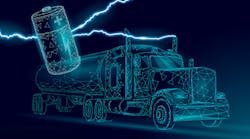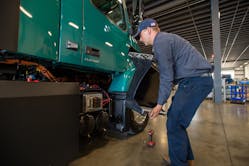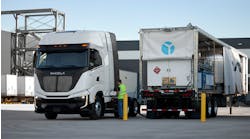Among the biggest barriers to adopting electric vehicles are maintaining them and training technicians on their upkeep. In a 2021 Commercial Electric Vehicle Adoption report performed by Endeavor Business Intelligence, 58% of fleet stakeholders identified maintenance and service training as a major challenge, which tied with upfront costs and was a close second to the cost of charging infrastructure (63%).
The right amount of planning and execution can oftentimes whittle insurmountable obstacles into mere speed bumps, and for as many maintenance questions that electric trucks pose, they appear to provide as many advantages. This was the takeaway from a recent Fleet Maintenance webinar hosted by Noregon, a provider of diagnostics tools and solutions, which tackled the subject of training and tool preparations a shop needs to service CEVs.
The first thing to know is that time is of the essence. According to that CEV adoption report, about three out of five fleets are not planning on getting EVs in the next three years. With the amount of upskilling and preparation needed, shops not immediately expecting to work on EVs should still begin planning and learning.
“Fleets need to be ready very soon,” said Scott Bolt, VP of product management at Noregon. “New federal emission standards are coming in 2030. California has enacted its own laws outside of the federal regulations, and they're requiring that 40% of all vehicles in California fleets be zero emissions by 2035. That is a fleet content target, and 26% of all new sales in 2030 are being projected to be electric.”
Several states are following California’s lead, so shops across the U.S. may be affected. Bolt predicted an accelerated ramp-up to begin in 2027, which means fleets and shops have about five years to get ready. For some duty cycles, the window for preparation is more of a glass shard.
Talon Thomas, technical engineer for Noregon’s product management group expected short-haul fleets to become the first adopters, due to the range limitations of current batteries. On one charge, an electric truck will likely have under a 250-mile range. The North American Council for Freight Efficiency has also identified regional haul as the best early use case for electric trucks as well.
“Many of the OEMs will open order books at the end of this year,” Thomas predicted. In the Class 8 market, the Freightliner eCascadia, Kenworth T680E, Peterbilt 579EV, and Volvo VNR Electric are already available, as is the Mack LR Electric refuse truck. There are several medium-duty trucks as well, such as the International eMV Series.
Because of the diversity, there will be a deluge of training needed at the onset for shops servicing all makes and models of electric vehicles.
Bolt said every OEM will have different controllers, with the information for each needing to be added to diagnostic tools. Maintenance procedures and wiring diagrams will also require updates. “It's a whole lot more than just a normal upgrade of model year,” Bolt said.
“There's going to be a big service literature influx that people are going to have in order to deal with these vehicles,” Bolt said.
Factory level OE technicians at dealerships will be the first to receive training and tools necessary to service electric trucks, Thomas said.
These will be under warranty for at least three years, Thomas noted, so “the aftermarket has a little bit of time to catch up.”
“They'll be able to test the waters to see what kinds of volume of electric vehicles are coming through the shops, and that should give them a chance to get ready for servicing more major components,” predicted Thomas, a former maintenance technician.
Infrastructure
A large portion of maintenance will be the same, as the vehicles look and behave the same way, and the shop landscape won’t need to change much—even though the powertrain is completely different. Heavy lifting tools such as a transmission jack can also be used to lift out the electric vehicle’s batteries, Thomas explained.
“The environment itself isn't going to change that much but you're going to have to have a little bit of additional infrastructure to cater to charging and handling batteries,” he added.
A shop wanting to work on EVs will have to have at least some method of charging them for a few reasons.
“They might come in the door with a low charge, or you might have to discharge them in order to perform certain maintenance,” Bolt said, though the shop needn’t provide a full charge. “They have to have some juice to get back home with, so they can charge themselves.”
These charging systems will also require training on how to diagnose faults and issues, which is a major departure from internal combustion engines.
“There's really not a whole lot of diagnosing the diesel spigot—generally, you reach out, you pull the handle, and fuel with it,” Bolt said. “The charging systems for these vehicles are very sophisticated, they have their own communications protocol and their own communication standards.
Bolt said if the charger is not behaving correctly, investigating and identifying if the problem is on the vehicle or charger side will take some extra time, as will deciding if the charger should be fixed or replaced.
A Volvo Trucks dealership called TEC Equipment has already begun its electric journey and recently shared some insights with Fleet Maintenance. According to Wayne Hammond, vice president, strategic initiatives at TEC:
“With appropriate shop tooling and technician training, TEC Equipment is servicing our EV customers much as we would any other customer, getting them in and out of the shop as quickly as possible. Our Volvo Certified EV Dealership locations maintain moderate-wattage chargers in the shop and high-speed charging on the lot. The costs for us have been the EVSE, the utility and construction work, and minor reconfiguration of certain shop bays.
“The benefits are many but a key one is helping take some of the complexity out of the EV transition, accelerating our customers’ readiness to go electric.”
Safety
There are already several electrical systems on a modern commercial vehicle, so technicians have already been trained on how to work on and troubleshoot these more complex systems. The most notable change for technicians to be aware of is the amount of power coursing through these far larger batteries.
“A typical commercial vehicle requires like 330 kW,” Bolt said. “Well, a Class 8 vehicle [needs] 50 MW.”
For this reason, everyone who works in the facility will need to understand the potential for danger, from the people who sweep the floor on up, with clear markings for the bay(s) where EVs are serviced.
“Just imagine what a 50-MW release through your body would do—it would vaporize you,” said Bolt, a former reactor controls operator aboard a nuclear-powered Permit-class submarine. “It's a very, very dangerous amount of stored energy that can be released very quickly.”
Bolt offered that “there's been a lot of progress made on the connections and the markings and the training for this, so you really have to work hard to hurt yourself by violating a whole lot of things and doing something silly like taking a Dremel [tool] into a big cable—but it's it is possible, and you need to know not to do these things.”
The main point is that a healthy amount of respect, and even more signage and training, will be an absolute must in the shop. These are all well within a shop’s current abilities, Bolt explained.
“It's not like there's not dangerous things out there today; we've been dealing with fuels that are explosive for years,” he said.
Thomas recalled working on even the diminutive Toyota Prius required all hands to be aware of the electrical danger.
“One of the things that stood out to me as a technician was when these vehicles did come in, unless you were trained for them, you would have to cordon off a bay to make everybody else in the shop aware of whatever was going on inside that bay,” he said.
Shop managers should prepare to invest in the types of insulated tools—including screwdrivers, ratchets, and mores—that an electrician would use, as well as high-voltage gloves. These will be needed when working near high-voltage connectors and cabling when the battery has not been disconnected, Thomas added.
Maintenance benefits
The preparation, training, and additional investments are a lot to take on, but in theory, electric trucks have been touted as saving time and money. Eschewing the aftertreatment system, which was implemented in the last round of major EPA emissions changes, will be a relief to many a shop.
“A lot of fleets are going to pick up and realize right away that overall reliability will be better right out the gate,” Thomas said. “There are not very many moving parts to an electric power train—most things are solid-state, and they are designed to handle the load that they're intended for. The vehicle should run longer and healthier with less maintenance.”
He also predicted scheduled preventive maintenance will be easier to plan around, with less downtime overall. The electric drivetrain and e-axles will still have some fluid and lubrication changes, but those will be less frequent.
While regeneration derates will not be an issue, a battery version of derating would still occur for battery and motor issues, Thomas said.
Regenerative braking will also ease the load of maintenance.
“Essentially, they use the electric motor as a mechanism of braking, in addition to a mechanism of accelerating, and what that basically means is you have no friction plates touching something, which means [the brake] doesn't wear,” Bolt said. “So in theory, you could have a Class 8 vehicle that you never service the brakes on.”
He also added it could be “millions of miles” before the motor wears out.
The balance between added complexities and benefits and, or the risk versus reward equation, will also take many millions of miles of testing for the industry to truly understand the total cost of ownership and impact on uptime. And shops, likewise, will have to experiment to find out the most efficient setup and training regiments, and how many chargers might be needed, to prepare for EVs, while still maintaining diesel and gas trucks.
The good thing is there is still time to make those preparations.
"It's not an immediate paradigm shift from fossil fuels to electric," Thomas said. "The industry and support services will have a chance to catch up and get ready for it."
For more details on how to prepare a shop for EVs, check out our August Fleet Maintenance cover story.





